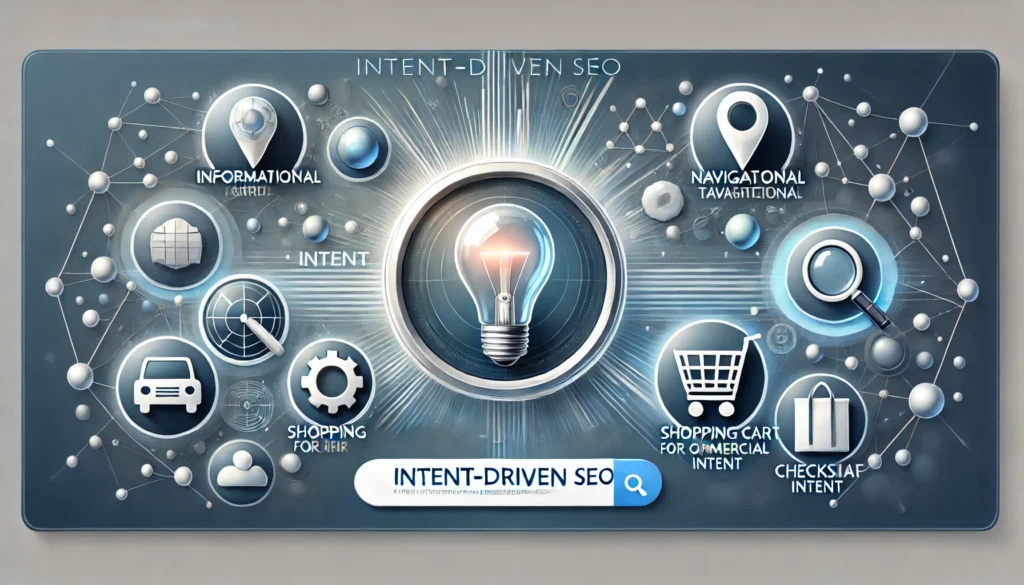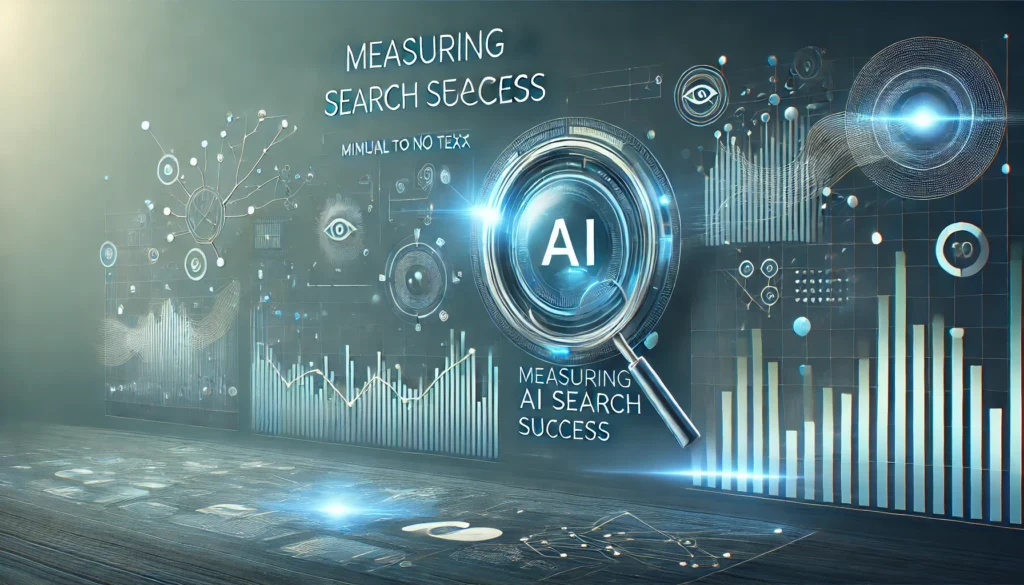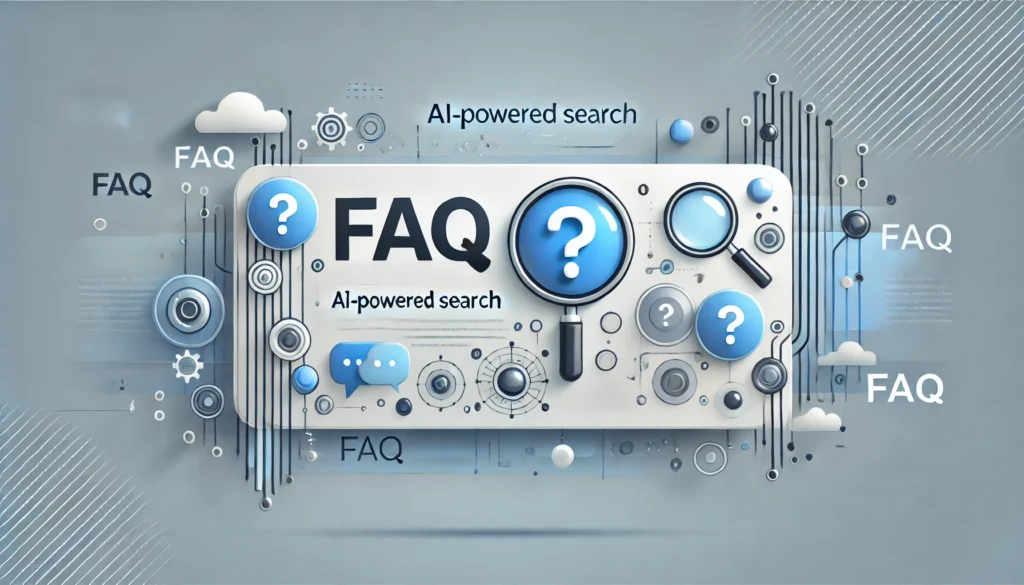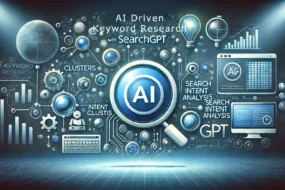
Key Takeaways:
- Intent-driven SEO is revolutionizing content optimization for AI-powered search engines
- Understanding and addressing user intent is crucial for enhancing content relevance and search performance
- AI-powered search engines prioritize context, semantics, and user experience over simple keyword matching
- Implementing structured data and natural language optimization significantly improves content visibility
- Adapting SEO strategies for voice search and conversational AI is becoming increasingly important
- Balancing technical SEO with high-quality, user-focused content is key to success in the AI-driven search landscape
Time to read: 20 minutes
The Rise of Intent-Driven SEO / GEO
Intent-driven SEO, now harnessed as GEO (Generative Engine Optimization) represents a paradigm shift from focusing solely on keywords to understanding and addressing the underlying purpose of a user’s search query. This approach aligns perfectly with the capabilities of AI-powered search engines, which are designed to interpret context, semantics, and user behavior to deliver more accurate and relevant results.
The concept of intent-driven SEO is rooted in the understanding that users approach search engines with specific goals in mind. These goals can range from finding quick information to making complex purchasing decisions. By aligning content with these diverse intents, websites can significantly improve their visibility and relevance in search results. In fact, Bing published thorough guidelines providing a deeper look under the hood of AI-powered generative engines and this guide will give context, as well as, clearer actionable methods of harnessing intent for AI.
Understanding User Intent
User intent can be broadly categorized into four types:
- Informational Intent: This category encompasses users seeking information or answers to questions. They might be looking for facts, explanations, or general knowledge on a topic. For example, “What is photosynthesis?” or “History of the Roman Empire.”
- Navigational Intent: Users with navigational intent are looking for a specific website or page. They often know exactly where they want to go but use a search engine as a quick way to get there. Examples include “Facebook login” or “Nike official website.”
- Commercial Intent: This intent involves users researching products or services before making a purchase. They’re in the consideration phase, comparing options, reading reviews, or seeking recommendations. Queries might include “Best smartphones 2024” or “Top-rated Italian restaurants near me.”
- Transactional Intent: Users with transactional intent are ready to make a purchase or complete a specific action. They’ve moved beyond research and are prepared to convert. Examples include “Buy iPhone 15 Pro” or “Book flight to Paris.”
Understanding these intents is crucial because it allows content creators to tailor their material to meet specific user needs. For instance, content addressing informational intent should be comprehensive and educational, while content for transactional intent should focus on facilitating the purchase process.
The Role of AI in Search Engines
AI-powered search engines, like Bing, utilize advanced algorithms and machine learning to:
- Interpret natural language queries more accurately: AI can understand the nuances of human language, including context and semantics, allowing for more precise interpretation of search queries.
- Understand context and user preferences: These systems can take into account factors like the user’s search history, location, and device to provide more personalized results.
- Analyze user behavior and search patterns: AI algorithms can identify trends in user behavior, allowing search engines to anticipate needs and improve result relevance over time.
- Deliver personalized search results: By combining all these factors, AI-powered search engines can provide highly tailored results that are more likely to satisfy the user’s specific intent.
This level of sophistication requires a more holistic approach to SEO, one that goes beyond simple keyword matching. Content creators must now consider the broader context of their material and how it fits into the user’s journey.
Implementing Intent-Driven SEO / GEO Strategies

To effectively optimize for AI-powered search engines, consider the following comprehensive GEO strategies:
1. Comprehensive Content Creation
Develop content that thoroughly addresses user queries and provides value beyond basic information. This approach involves creating a diverse range of content types that cater to different aspects of user intent:
- In-depth articles and guides: These should offer comprehensive coverage of topics, answering potential follow-up questions and providing context. For example, an article on “How to Start Investing” should cover basics, different investment types, risk management, and long-term strategies.
- Multimedia content (videos, infographics, podcasts): Diversifying content formats caters to different learning preferences and can improve engagement. For instance, complex topics like “Understanding Quantum Computing” might benefit from visual explanations through infographics or video tutorials.
- Interactive tools and calculators: These can provide personalized insights and enhance user engagement. Examples include mortgage calculators for real estate sites or carbon footprint calculators for environmental blogs.
- User-generated content and forums: Encouraging community participation can provide fresh perspectives and address a wide range of specific user queries.
2. Structured Data and Schema Markup
Implement structured data to help AI-powered search engines better understand your content. This involves using schema.org vocabulary to provide explicit clues about the meaning of a page or content piece.
Here’s an expanded example:
<script type="application/ld+json">
{
"@context": "https://schema.org",
"@type": "Article",
"headline": "The Value of Intent-Driven SEO in AI-Powered Search Engines",
"author": {
"@type": "Person",
"name": "SEO Expert",
"url": "https://www.example.com/author/seo-expert"
},
"datePublished": "2024-11-28T16:00:00-08:00",
"dateModified": "2024-11-28T16:00:00-08:00",
"description": "Explore the importance of intent-driven SEO strategies for AI-powered search engines and learn how to implement them effectively.",
"image": "https://www.example.com/images/intent-driven-seo.jpg",
"publisher": {
"@type": "Organization",
"name": "SEO Insights Blog",
"logo": {
"@type": "ImageObject",
"url": "https://www.example.com/logo.png"
}
},
"mainEntityOfPage": {
"@type": "WebPage",
"@id": "https://www.example.com/blog/intent-driven-seo"
},
"keywords": "intent-driven SEO, AI search engines, user intent, content optimization"
}
</script>
This structured data provides search engines with detailed information about the article, including its author, publication date, description, and associated organization. Such markup can improve the chances of content appearing in rich snippets and enhance its overall visibility in search results.
3. Natural Language Optimization
Optimize content for natural language queries, considering:
- Long-tail keywords and phrases: Focus on more specific, conversational phrases that align with how people naturally speak or type queries. For example, instead of just targeting “weight loss,” consider phrases like “how to lose weight safely in your 40s.”
- Question-based content (FAQs, Q&A sections): Create content that directly answers common questions in your niche. This can improve your chances of appearing in featured snippets and voice search results.
- Conversational tone and style: Write in a way that mirrors natural speech patterns. This makes content more engaging and aligns with voice search queries.
- Semantic relationships: Use related terms and concepts to provide context and depth to your content. For instance, an article about “renewable energy” might also include terms like “solar power,” “wind turbines,” and “sustainability.”
4. User Experience Enhancement
Prioritize user experience factors that AI-powered search engines value:
- Fast loading times: Optimize images, leverage browser caching, and consider using a content delivery network (CDN) to improve page speed.
- Mobile responsiveness: Ensure your website provides a seamless experience across all devices, with easily readable text, accessible navigation, and properly sized touch targets.
- Intuitive navigation: Create a logical site structure with clear menus and internal linking that helps users (and search engines) easily find related content.
- Accessibility features: Implement alt text for images, use descriptive anchor text for links, and ensure your site is navigable via keyboard for users with disabilities.
- Engagement elements: Incorporate features like comment sections, social sharing buttons, and related content suggestions to encourage user interaction and longer site visits.
5. Entity-Based SEO
Focus on building entity associations and relationships within your content:
- Use clear and consistent entity names: Ensure that people, places, and things are referred to consistently throughout your content and align with how they’re commonly known.
- Link to authoritative sources: Provide context and credibility by linking to reputable external sources when referencing facts, statistics, or complex concepts.
- Create content that establishes topical authority: Develop comprehensive resource pages or content hubs that cover all aspects of a particular topic or entity.
- Implement entity markup: Use schema.org vocabulary to explicitly define entities mentioned in your content, helping search engines understand the relationships between different concepts.
Adapting to Voice Search and Conversational AI

As voice search becomes more prevalent, optimizing for conversational queries is crucial:
- Use natural, conversational language in content: Write in a way that mirrors how people speak, incorporating questions and answers into your content structure.
- Target featured snippets and position zero opportunities: Create concise, informative paragraphs that directly answer common questions in your niche.
- Optimize for local search with location-specific content: Include region-specific information, address details, and local landmarks in your content to improve relevance for “near me” searches.
- Focus on long-tail, question-based keywords: Incorporate phrases like “how to,” “what is,” and “where can I find” into your content to align with voice search patterns.
- Consider the context of voice searches: Optimize for queries that might be made on-the-go or hands-free, such as “directions to” or “call” queries for local businesses.
Balancing Technical SEO and Content Quality
While technical SEO remains important, AI-powered search engines place a premium on high-quality, relevant content. Here’s an expanded look at how to balance these aspects:
| Technical SEO | Content Quality |
|---|---|
| Site speed optimization: Implement caching, optimize images, and minimize code to ensure fast loading times across all devices. | In-depth, authoritative content: Create comprehensive guides, detailed analyses, and expert insights that provide substantial value to users. |
| Mobile-first indexing: Ensure your site is fully optimized for mobile devices, with responsive design and touch-friendly navigation. | User-focused information: Tailor content to address specific user needs, questions, and pain points within your niche. |
| XML sitemaps: Maintain up-to-date sitemaps that help search engines efficiently crawl and index your site’s content. | Engaging multimedia: Incorporate videos, infographics, and interactive elements to enhance user engagement and provide information in various formats. |
| Robots.txt optimization: Use robots.txt strategically to guide search engines on which parts of your site to crawl and index. | Regular updates and freshness: Consistently publish new content and update existing articles to maintain relevance and authority. |
| Canonical tags: Implement canonical tags to avoid duplicate content issues and consolidate ranking signals. | Unique insights and perspectives: Offer original research, expert opinions, and innovative ideas that set your content apart from competitors. |
| Schema markup: Use structured data to provide explicit information about your content, enhancing rich snippet opportunities. | Comprehensive topic coverage: Create content clusters that cover all aspects of a subject, establishing topical authority. |
| Internal linking structure: Develop a logical, hierarchical internal linking strategy that helps users and search engines navigate your content. | Storytelling and narrative: Use compelling narratives and real-world examples to make complex information more accessible and engaging. |
Measuring Success in AI-Powered Search

Traditional SEO metrics remain relevant, but new KPIs are emerging:
- Click-through rates (CTR) for featured snippets: Monitor how often users click on your content when it appears in featured snippets or rich results.
- Voice search result accuracy: Assess how often your content is selected as the answer for voice search queries in your niche.
- User engagement metrics: Pay close attention to time on page, bounce rate, and pages per session as indicators of content relevance and quality.
- Content relevance scores: Some advanced SEO tools now offer content relevance scores based on AI analysis of your content against top-ranking competitors.
- Semantic search visibility: Track your rankings for semantically related keywords and topics, not just exact-match phrases.
- User feedback and sentiment: Monitor comments, social media mentions, and other forms of user feedback to gauge the perceived value of your content.
- Conversion rates for intent-specific content: Measure how well your content converts based on its alignment with different user intents (informational, commercial, etc.).
The Future of Intent-Driven SEO
As AI continues to evolve, we can expect:
- More sophisticated natural language processing: AI will become even better at understanding context, sentiment, and nuanced language, requiring content to be increasingly natural and conversational.
- Increased personalization of search results: Search engines will deliver highly tailored results based on individual user profiles, search history, and real-time context.
- Greater emphasis on user context and intent: The importance of understanding and addressing specific user needs will continue to grow, with AI becoming more adept at discerning subtle differences in intent.
- Integration of augmented reality (AR) in search: As AR technology advances, search results may include interactive, real-world overlays, requiring new forms of content optimization.
- Predictive search capabilities: AI may begin to anticipate user needs and provide information before explicit searches are made, based on patterns and contextual data.
- Enhanced voice and visual search: Optimization for voice commands and image-based searches will become increasingly important as these technologies mature.
- Ethical AI and transparency: There will likely be a growing focus on explainable AI in search, with potential regulations requiring more transparency in how search results are determined.
Action Steps for Implementing AI-Friendly SEO
Conduct Intent Research:
- Utilize advanced keyword research tools to analyze search queries and identify underlying user intents.
- Conduct user surveys and interviews to gain direct insights into your audience’s needs and search behaviors.
- Analyze search query reports in Google Search Console to understand how users are finding your content.
- Study user comments, forum discussions, and social media conversations to identify common questions and concerns in your niche.
Create Intent-Optimized Content:
- Develop comprehensive content that addresses all aspects of identified user intents.
- Structure content to directly answer common questions and provide clear, actionable information.
- Use headings, bullet points, and tables to improve readability and make information easily digestible.
- Incorporate multimedia elements like videos, infographics, and interactive tools to cater to different learning preferences.
Implement Structured Data:
- Use schema markup to provide explicit context about your content, products, or services.
- Implement organization, article, product, and other relevant schema types to enhance rich snippet opportunities.
- Regularly test and validate your structured data implementation to ensure accuracy and completeness.
Optimize for Voice Search:
- Focus on long-tail, conversational keywords that mirror natural speech patterns.
- Create FAQ sections that directly answer common voice search queries in your niche.
- Optimize for local search by including location-specific information and landmarks in your content.
- Ensure your content is easily readable and structured for quick comprehension by voice assistants.
Enhance User Experience:
- Conduct regular site speed audits and optimize for fast loading times across all devices.
- Implement a responsive design that provides a seamless experience on desktop, tablet, and mobile devices.
- Improve site navigation and internal linking to help users easily find related content.
- Enhance accessibility features to ensure your content is available to all users, regardless of abilities.
Build Topical Authority:
- Create comprehensive content hubs or pillar pages that cover all aspects of key topics in your niche.
- Develop a consistent publishing schedule to regularly add depth and breadth to your content offerings.
- Engage with industry experts and thought leaders to incorporate diverse perspectives into your content.
- Participate in relevant online communities and forums to establish your brand as a knowledgeable resource.
Leverage AI Tools:
- Utilize AI-powered SEO tools for content optimization, keyword research, and competitor analysis.
- Experiment with AI writing assistants to generate content ideas and improve content structure.
- Implement chatbots or AI-powered customer service tools to enhance user engagement and gather insights on user needs.
- Use AI-driven analytics platforms to identify content gaps and opportunities for improvement.
Monitor AI-Specific Metrics:
-
- Set up tracking for featured snippet appearances and click-through rates.
- Implement voice search tracking to measure how often your content is selected for voice queries.
- Monitor user engagement metrics like time on page, bounce rate, and pages per session across different content types.
- Use advanced SEO tools to track semantic search visibility and content relevance scores.
Stay Informed:
-
- Follow official blogs and announcements from major search engines like Google and Bing.
- Attend industry conferences and webinars focused on AI and search technology.
- Participate in SEO and digital marketing communities to share insights and learn from peers.
- Regularly review academic papers and research on natural language processing and search algorithms.
Experiment and Iterate:
-
- Conduct A/B tests on content formats, structures, and optimization techniques.
- Implement changes based on performance data and user feedback.
- Continuously refine your content strategy based on evolving search trends and user behaviors.
- Be willing to adapt quickly to new AI-driven search features and algorithm updates.
Conclusion
The advent of AI-powered search engines has ushered in a new era of SEO, one where understanding and addressing user intent is paramount. This shift represents both a challenge and an opportunity for businesses and content creators. By embracing intent-driven SEO strategies, organizations can not only improve their search engine rankings but also provide more value to their audience, fostering stronger connections and driving meaningful engagement.
As AI continues to shape the search landscape, those who adapt their SEO approaches to align with these advanced technologies will be best positioned for success in the digital marketplace. This adaptation requires a multifaceted approach that combines technical expertise, creative content creation, and a deep understanding of user psychology and behavior.
The future of SEO lies in the seamless integration of technical optimization, high-quality content creation, and a nuanced understanding of user intent. By focusing on these elements, websites can thrive in the age of AI-powered search, delivering relevant, valuable content to users while achieving their own visibility and engagement goals.
Frequently Asked Questions (FAQs)What is Intent-Driven SEO?

Intent-driven SEO represents a sophisticated approach to search engine optimization that transcends traditional keyword targeting. Unlike previous SEO strategies that focused narrowly on exact-match keywords, this methodology delves deep into understanding the underlying motivations, needs, and context of user search queries.
At its core, intent-driven SEO recognizes that every search is a human interaction with a specific purpose. For instance, when someone searches “best running shoes,” they might be seeking product recommendations, comparative reviews, or detailed performance insights. An intent-driven approach means creating content that comprehensively addresses these potential motivations, providing valuable, nuanced information that directly speaks to the user’s potential goals.
This strategy requires a holistic understanding of user psychology, search behavior, and content development. It involves analyzing search patterns, user engagement metrics, and developing content that not only ranks well but genuinely serves the user’s informational or transactional needs.
Why is User Intent Crucial for SEO?
User intent has become the cornerstone of modern search engine algorithms, particularly with the advancement of AI-powered search technologies. Search engines like Google and Bing have evolved from simple keyword-matching machines to sophisticated systems that can interpret context, semantics, and user behavior.
By prioritizing user intent, search engines aim to deliver more personalized, relevant results. This means that websites which successfully align their content with user intent are more likely to achieve higher rankings, increased click-through rates, and improved user engagement. For example, a well-crafted article that thoroughly answers a specific query is more likely to be featured in featured snippets or rank higher in search results.
Moreover, understanding user intent allows businesses to create more targeted, valuable content. Instead of producing generic, keyword-stuffed articles, companies can develop in-depth resources that genuinely help users solve problems, make informed decisions, or satisfy their informational needs.
How Do I Identify User Intent for Target Keywords?
Identifying user intent requires a multi-faceted approach that combines data analysis, user research, and strategic content development. Modern SEO professionals utilize a range of sophisticated tools and methodologies to decode the complex landscape of search intent.
Start by leveraging advanced keyword research tools like SEMrush, Ahrefs, or Google’s Keyword Planner. These platforms provide insights into search volume, related queries, and user behavior patterns. Analyze the current top-ranking content for your target keywords to understand the type of information users are seeking.
Consider implementing techniques such as:
- Conducting user surveys and interviews
- Analyzing search query reports in Google Search Console
- Studying user comments and forum discussions
- Utilizing AI-powered content analysis tools
- Examining the semantic relationships between keywords
By combining these methods, you can develop a nuanced understanding of the different intents behind search queries and create content that precisely matches user expectations.
What Role Does Structured Data Play in Intent-Driven SEO?
Structured data serves as a critical communication bridge between your website’s content and search engine algorithms. By implementing schema markup, you provide explicit context about your content, helping AI-powered search engines understand the precise nature and purpose of your information.Think of structured data as a detailed metadata layer that goes beyond traditional HTML. It allows you to specify intricate details about your content, such as:
- Article type and authorship
- Product specifications and pricing
- Event details and schedules
- Review ratings and testimonials
- Organization information
This additional context enables search engines to generate rich snippets, enhanced search results, and more accurate content categorization. For businesses, this means potentially higher visibility, improved click-through rates, and a more prominent presence in search results.
How Can I Optimize Content for Voice Search?
Voice search optimization represents a critical evolution in SEO strategy, reflecting the growing prevalence of digital assistants and smart devices. Unlike traditional text-based searches, voice queries tend to be more conversational, longer, and often phrased as complete questions.
To effectively optimize for voice search, consider these comprehensive strategies:
- Develop content that answers specific questions conversationally
- Focus on long-tail keywords and natural language phrases
- Create detailed FAQ sections that address common queries
- Optimize for local search by including location-specific information
- Ensure content is easily readable and structured for quick comprehension
- Improve website loading speed and mobile responsiveness
- Use natural, conversational language that mirrors spoken communication
Voice search optimization requires thinking beyond traditional SEO tactics and understanding the nuanced ways people verbally interact with technology.
What Are Common Mistakes to Avoid in Intent-Driven SEO?
Navigating the complex landscape of intent-driven SEO requires awareness of potential pitfalls that can undermine your optimization efforts. Common mistakes include:
- Keyword Myopia: Fixating on exact-match keywords while neglecting the broader context of user intent
- Content Superficiality: Creating shallow, generic content that fails to provide genuine value or depth
- Ignoring User Experience: Neglecting technical aspects like site speed, mobile responsiveness, and intuitive navigation
- Lack of Continuous Learning: Failing to stay updated with evolving search engine algorithms and user behavior trends
- Overlooking Analytics: Not regularly analyzing performance metrics and user engagement data
- Inconsistent Content Strategy: Producing content without a cohesive, intent-focused approach
By understanding and avoiding these mistakes, businesses can develop more robust, user-centric SEO strategies.
How Frequently Should I Update My SEO Strategy?
In the rapidly evolving digital landscape, SEO is not a set-it-and-forget-it endeavor. With AI-powered search technologies continuously advancing, maintaining an agile, adaptive SEO strategy is crucial.
Recommended update frequencies:
- Conduct comprehensive strategy reviews every 3-4 months
- Monitor performance metrics monthly
- Stay informed about search engine algorithm updates
- Continuously experiment with new optimization techniques
- Regularly analyze user behavior and engagement data
The key is maintaining a proactive, data-driven approach that balances strategic consistency with innovative adaptation.
Search
Recent Posts
ChatGPT Search Goes Account-Free: The Future of
- February 7, 2025
- 13 min read
Strategies to Dominate Consumer Searches with AI
- January 13, 2025
- 15 min read
Boost Visibility: Integrate GEO with SEO Strategies
- January 6, 2025
- 6 min read








